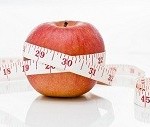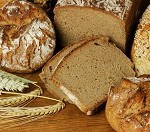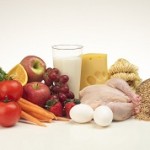
We are a society that likes to live large. This is especially true when it comes to how much we eat. Understanding what to eat is vitally important to good health. Understanding how much to eat is equally important when it comes to
controlling our weight.
http://www.choosemyplate.gov illustrates the 5 food groups that are the essential pieces to a healthy diet. The groups include: fruits, vegetables, grains, protein and dairy. Eating a variety of foods from each of these
groups is important. Knowing how much to eat can get confusing. Reading food
labels is a good way to start, but even that information can be complicated.
What you really need to know is: how much of each food group you need, and what
a serving from each group looks like. The amount of food and individual needs from each food group depends on that individual’s age, sex and level of physical activity. For the purpose of this article we will assume an adult male, aged 18-50 years old, who gets less than 30 minutes a day of moderate exercise (those who are more physically active may be able to consume more).
Fruits-Any fruit or 100% fruit juice can count toward your daily goal of making at least
half your plate consist of fruits and vegetables. The following are all examples of serving
sizes that would count toward your daily recommended intake:
1 piece of fruit the size of a tennis ball (apple, peach, pear, etc.)
1 large banana
1 cup of canned fruit
½ cup of dried fruit
1 cup of 100% fruit juice
*A healthy diet consists of no less than 2 servings of fruit per day. Keeping fresh fruit in a bowl on the counter so that it is visible and easily accessible will help to remind you to reach for fruit at least twice a day.
Vegetables-Remember at least half your plate at each meal should consist of fruits and
vegetables. 3 cups of vegetables a day meet the requirement for daily intake. A serving of vegetables could include:
1 medium baked potato
1 cup of mashed potatoes
1 cup of fresh or cooked vegetables
1 cup of 100% vegetable juice
2 cups of fresh, leafy greens-about the size of a softball
*Keep fresh, easy to prepare veggies like baby carrots, celery sticks or snap peas in the fridge to
grab for a quick, healthy snack or as a side to a meal.
Grains-Bread, pasta, cereal, and tortillas all fall into this category. At least half of the grains in your diet s hould consist of whole grains. 7 or 8 one ounce servings of grains should be a part of your daily food intake. Examples of a one ounce serving of grains would include:
hould consist of whole grains. 7 or 8 one ounce servings of grains should be a part of your daily food intake. Examples of a one ounce serving of grains would include:
1 “mini” bagel
1 slice of bread
5 whole wheat crackers
½ English muffin
1 packet of instant oatmeal
1 cup of breakfast cereal (about one large handful)
½ cup of cooked rice or pasta (about the size of a baseball)
1 six inch corn or flour tortilla
*Using whole grain breads in place of white bread, cooking with brown rice instead of white rice and
substituting whole wheat pasta for regular pasta are all great ways to get the
recommended amounts of whole grains in your diet.
Protein-Meat, poultry, seafood, beans, eggs and nuts are all considered part of the protein
group. Most Americans get enough protein in their diets. The important thing to remember is to chose leaner meats and incorporate a wider variety of proteins. Six one ounce servings of protein are recommended daily. A one ounce serving of protein could include:
1 sandwich slice of turkey, chicken, ham or other lean meat
1 Tbsp of peanut butter
1 egg
¼ cup of cooked beans
12 almonds
1Â small, lean hamburger would equal 2-3 ounces of protein
A chicken breast, the size of a deck of cards, would equal 3 ounces of protein
1Â can of tuna counts for 3-4 ounces of protein
1Â cup of bean soup is about 2 ounces of protein
*Buying lean cuts of meat and trimming any excess fat before cooking, removing the skin from chicken and turkey before cooking or eating and avoiding frying foods are all great ways to help make the proteins you choose, healthy choices. Including seafood in your diet at least twice a week is a great healthy choice of protein and may lower your risk of heart disease.
Dairy-Milk, cheese, yogurt and ice cream are part of the dairy group. 3 cups of low-fat or fat-free dairy are needed in a healthy diet each day. A serving of dairy might be: 
1 cup of (skim or 1%) milk
an 8 ounce container of yogurt
1 ½ ounces of cheese (the size of six dice)
1 cup frozen yogurt
1 cup calcium fortified soy milk
*Great ways to get good tasting dairy in your diet are to make fruit & yogurt smoothies, add low-fat or skim milk to oatmeal instead of water, make dips for fruits and veggies with yogurt instead of sour cream or cream cheese.
Committing to getting healthy and eating well are great goals in the New Year. Getting the
necessary nutrients without overeating will help you be successful in controlling your weight and feeling good. Choose to live large by living well!



